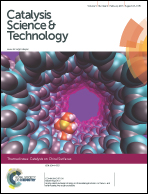Factors influencing the catalytic oxidation of benzyl alcohol using supported phosphine-capped gold nanoparticles†
Abstract
Two phosphine-stabilised gold clusters, Au101(PPh3)21Cl5 and Au9(PPh3)8(NO3)3, were deposited and activated on anatase TiO2 and fumed SiO2. These catalysts showed an almost complete oxidation of benzyl alcohol (>90%) within 3 hours at 80 °C and 3 bar O2 in methanol with a high substrate-to-metal molar ratio of 5800 and turn-over frequency of 0.65 s−1. Factors influencing catalytic activity were investigated, including metal–support interaction, effects of heat treatments, chemical composition of gold clusters, the size of gold nanoparticles and catalytic conditions. It was found that the anions present in gold clusters play a role in determining the catalytic activity in this reaction, with NO3− diminishing the catalytic activity. High catalytic activity was attributed to the formation of large gold nanoparticles (>2 nm) that coincides with partial removal of ligands which occurs during heat treatment and catalysis. Selectivity towards the formation of methyl benzoate can be tuned by selection of the reaction temperature. The catalysts were characterised using transmission electron microscopy, UV-vis diffuse reflectance spectroscopy and X-ray photoelectron spectroscopy.


 Please wait while we load your content...
Please wait while we load your content...